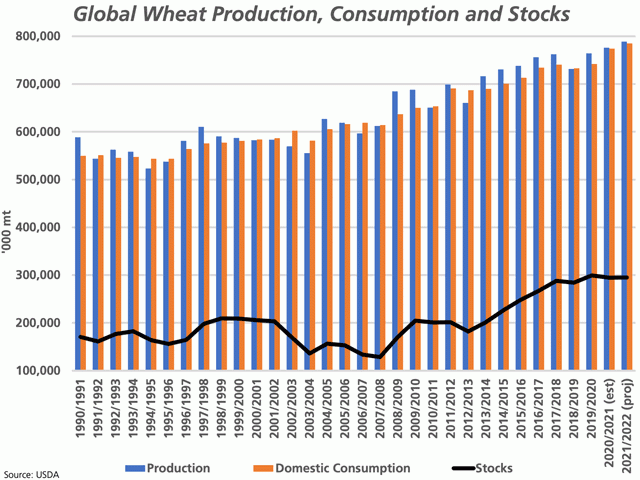Canada Markets
Global Wheat Production Forecast to Grow, Along With Use
USDA's first look at the 2021-22 crop year shows the forecast for global wheat production (blue bars) and global wheat consumption (brown bars) increasing together for a third straight year and for the ninth time in 11 years. While global production is to increase to a record 788.98 million metric tons, global use is to increase to a record 788.68 mmt, according to USDA's official tables. Data obtained by USDA's Foreign Agricultural Service tables, as seen on the accompanying chart, shows demand increasing to 785.297 mmt.
Using FAS table data, the production forecast for 2021 exceeds consumption by 3.681 mmt, which compares to the five-year average of 13.3 mmt, the 10-year average of 12.9 mmt and the 25-year average of 8.8 mmt.
P[L1] D[0x0] M[300x250] OOP[F] ADUNIT[] T[]
Rising demand continues to keep ending stocks in check. Wednesday's ending stocks forecast of 294.962 mmt was below the average of pre-report estimates of 299.4 mmt, while is up a modest 295,000 metric tons from the previous crop year. Global stocks have fallen in two of the past three years, while the increase for 2021-22 is very small. Despite stocks falling year-over-year in two of the past three years, stocks rose by an average of 9.2 mmt over each of the past five years, making the current forecast increase seem negligeable.
Using FAS data (not shown), stocks of the eight major global exporters are to rise slightly to 62.277 mmt, or 21.1% of global stocks. This is the first increase in volume seen by these eight exporters in four years, while is the second consecutive increase seen in the percentage of total stocks after reaching a low of 20.7% based on estimates for 2019-20.
The largest year-over-year increase for 2020-21 is seen in Russia, with stocks to grow by 3 mmt, while stocks are forecast to fall in North America, with U.S. stocks to fall by 2.7 mmt in 2021-22 to 21.054 mmt, the lowest shown in seven years, and Canadian stocks are currently forecast to remain unchanged from 2020-21 at 3.832 mmt, the lowest stocks that USDA reports for Canada in data going back to 1960.
While the first estimates of the season are always of interest, the 2021-22 crop year has yet to start, and there is a long list of factors that will lead to change in the monthly outlooks that lie ahead.
Cliff Jamieson can be reached at cliff.jamieson@dtn.com
Follow him on Twitter @Cliff Jamieson
(c) Copyright 2021 DTN, LLC. All rights reserved.






Comments
To comment, please Log In or Join our Community .